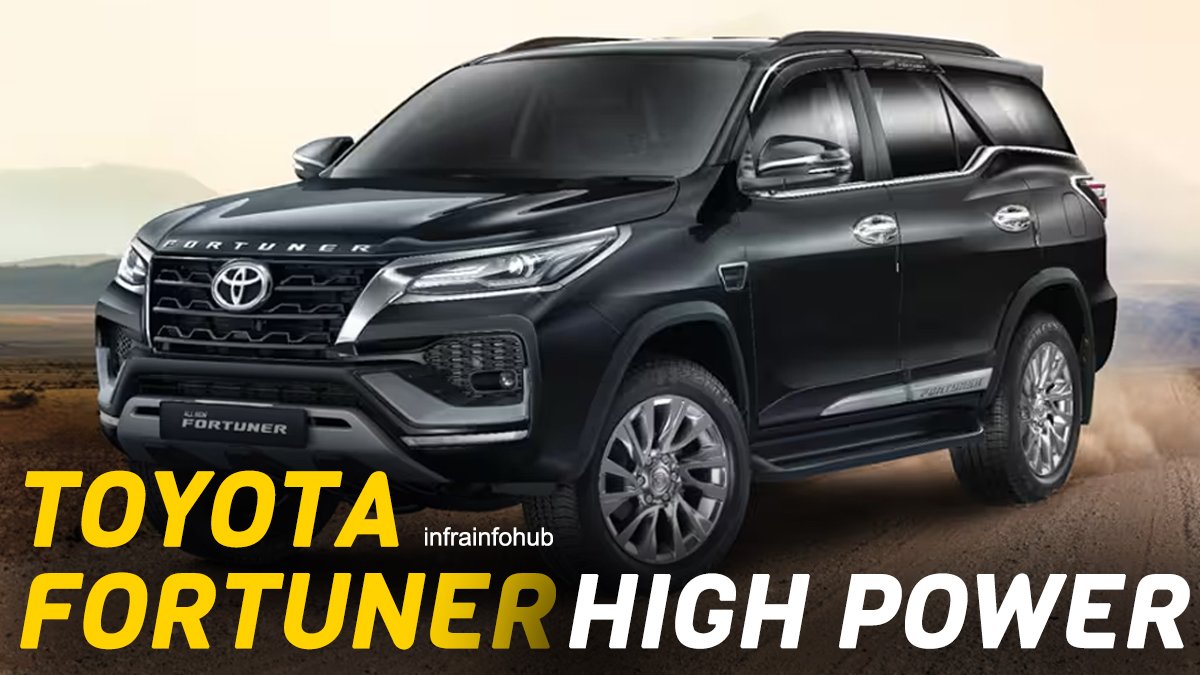In today’s competitive SUV landscape, only a few models manage to stand out for their blend of practicality, power, and prestige. The Toyota Fortuner is one such standout, carving a distinctive niche as a premium SUV known for its robust performance, commanding road presence, and exceptional reliability.
For those seeking a vehicle that seamlessly blends luxury and capability, the Fortuner presents a compelling proposition, offering an unparalleled driving experience that remains unmatched by many of its competitors.
Toyota Fortuner – A Design That Commands Attention
The latest generation Toyota Fortuner showcases a design that perfectly balances muscular aggression with refined sophistication. Its imposing front fascia features a bold chrome-accented grille, framed by sleek LED headlamps that sweep dramatically into the fenders, creating a powerful yet polished front profile.
Automotive enthusiast Rajesh Sharma remarks, “The first thing that struck me about the Fortuner was its imposing presence. It’s not just large – it’s architecturally commanding in a way that can’t be fully appreciated in photos.”
The side profile reveals a confident stance, emphasized by pronounced wheel arches that house substantial alloy wheels – 17-inch on base variants and up to 18-inch on premium trims. The floating roof design, achieved through blacked-out pillars, adds a contemporary flair to the Fortuner’s rugged silhouette, while LED combination taillights with distinctive light signatures ensure it remains recognizable even at night.
Available in seven striking colors, including Phantom Brown and Sparkling Black Crystal Shine, the Fortuner allows owners to express their individual style without compromising the vehicle’s inherent premium character. Higher trims like the Legender and GR Sport further stand out with unique styling elements that enhance the Fortuner’s visual impact.
Cabin Refinement That Reflects Premium Ambitions
Stepping inside the Fortuner reveals an interior that successfully balances luxury with the practicality expected of a true SUV. The dashboard is driver-focused, with an intuitive layout that places key controls within easy reach. High-grade materials, including soft-touch surfaces and premium leather upholstery on higher trims, reinforce the Fortuner’s upscale positioning.
The seats themselves are wide, supportive, and designed for long-distance comfort, with ventilated options available in premium variants to combat hot weather. Priya Menon, a recent Fortuner owner, notes, “What impressed me most about the Fortuner’s interior is its blend of luxury and durability. The leather feels substantial, and every switch has a reassuring, solid action.”
With a seven-seat configuration, the Fortuner offers genuine versatility. The second-row seats provide ample legroom, thanks to a generous 2,745mm wheelbase, while the third row, though best suited for shorter journeys, can accommodate adults when needed. When not in use, the third-row seats fold away to reveal a substantial 716-liter cargo area, enhancing the Fortuner’s practicality.
The technology package is equally impressive, featuring an 8-inch touchscreen infotainment system with smartphone connectivity, a partially digital instrument cluster, and premium audio systems that deliver an immersive sound experience.
Power That Matches Its Presence
At the heart of the Fortuner’s appeal are its powertrain options, designed to deliver performance that matches its bold styling. The lineup includes a 2.7-liter naturally aspirated petrol engine producing 166 PS and 245 Nm of torque, and a more powerful 2.8-liter turbocharged diesel engine, which delivers an impressive 204 PS and up to 500 Nm of torque in automatic variants.
Automotive journalist Vikram Desai notes, “The diesel Fortuner has a unique character – it’s responsive from low revs, providing effortless acceleration and exceptional towing capability.”
Transmission options include a precise 6-speed manual or a smooth 6-speed automatic, with four-wheel drive available on select variants. Multiple drive modes – Eco, Normal, and Sport – adjust the Fortuner’s throttle response and transmission behavior to suit different driving conditions, making it equally at home on city streets or rugged trails.
Off-Road Capability That Sets It Apart
Built on a robust body-on-frame chassis, the Fortuner maintains the rugged durability that has long been a Toyota hallmark. With up to 225mm of ground clearance, a lockable center differential, and a low-range transfer case in 4×4 models, the Fortuner can confidently tackle challenging terrain that would halt many competitors.
This off-road prowess is complemented by driver aids like hill descent control and hill-start assist, which further enhance its capability in difficult conditions. Despite its rugged nature, the Fortuner remains composed on paved roads, offering a well-judged balance of comfort and control.
Safety and Peace of Mind
Safety has always been a priority for Toyota, and the Fortuner is no exception. It comes equipped with seven airbags, including a driver knee airbag, along with advanced systems like Vehicle Stability Control (VSC) and Traction Control for added peace of mind.
Higher trims also benefit from advanced features like Blind Spot Monitoring, Rear Cross Traffic Alert, and, in some markets, Toyota’s Safety Sense suite, which includes autonomous emergency braking and adaptive cruise control.
The Ownership Experience
Toyota’s reputation for reliability is perhaps best exemplified by the Fortuner, which often reaches over 300,000 kilometers with minimal issues. This long-term dependability translates to exceptional resale value, making it a smart long-term investment.
Rahul Mehta, a long-time Fortuner owner, shares, “What keeps bringing me back is the peace of mind. I’ve never had a major issue, and the resale value is consistently strong.”
Conclusion: A Premium SUV That Delivers on Its Promises
For those seeking a premium SUV that delivers on its promises of power, luxury, and capability, the Toyota Fortuner remains a standout choice. It seamlessly blends executive presence with genuine off-road ability, creating a package that few competitors can match in the long run.
FAQ: Toyota Fortuner
How do the upkeep costs of the Fortuner measure up against other premium SUVs?
The Toyota Fortuner stands apart with its relatively modest maintenance expenses, particularly when compared to its European counterparts. This advantage stems from its more straightforward mechanical architecture and the extensive availability of components, which reduces overall service costs.
Scheduled maintenance is typically required every 10,000 kilometers or six months, whichever arrives first. Routine services generally fall within the ₹5,000-8,000 range, while more comprehensive overhauls, often needed between 40,000 to 50,000 kilometers, can command fees from ₹15,000 to ₹25,000, contingent on the extent of part replacements required.
Diesel variants, while more economical in terms of fuel consumption, tend to incur slightly higher maintenance costs due to their intricate emissions systems. However, these expenses are often counterbalanced by the long-term fuel savings.
One of the Fortuner’s significant advantages is its reliance on globally shared Toyota components, ensuring robust part availability at competitive prices. Additionally, its body-on-frame construction, though heftier, proves more resilient to minor impacts, reducing repair expenses in comparison to the lighter, more fragile unibody structures favored by many crossover rivals.
Is the third-row seating in the Fortuner practical for adult passengers?
The Fortuner’s third row offers a passable level of comfort for adults, surpassing many competitors yet still presenting certain limitations. It can reasonably accommodate individuals up to approximately 5’8″ (173 cm) for short to medium-length journeys, provided the second-row occupants are willing to compromise on legroom by sliding their seats forward.
This row benefits from independent air conditioning vents and cup holders, enhancing passenger comfort. Access is relatively straightforward, with the second row folding and tumbling forward to facilitate entry.
However, the elevated floor—an inherent trait of its rear-wheel-drive and four-wheel-drive architecture—leads to a somewhat awkward seating posture, with passengers’ knees positioned higher than ideal.
For families with teenage members or those occasionally transporting adult passengers, the Fortuner presents a pragmatic choice. Nevertheless, for those who routinely require full third-row seating, a vehicle specifically designed for passenger transport, such as the Innova Crysta, might prove more suitable.
How adept is the Fortuner in off-road conditions when compared to purpose-built off-roaders?
Occupying the nexus between urban-oriented SUVs and dedicated off-road vehicles, the Fortuner stands as a versatile contender. With up to 225mm of ground clearance, robust low-range gearing in 4×4 variants, and favorable approach and departure angles, it is well-equipped to tackle challenging terrains that would daunt most crossovers.
Its suite of electronic assists, including downhill assist control and active traction management, further bolsters its off-road prowess. However, it lacks certain hardcore features like front and rear locking differentials and sway bar disconnects, which are standard in purpose-built off-roaders like the Jeep Wrangler or Land Rover Defender.
For the majority of owners, the Fortuner’s capabilities are more than sufficient for beach runs, forest trails, and moderate rock crawling. Only those venturing into extreme rock gardens or deep mud pits might find its limitations more pronounced.
What differentiates the petrol and diesel engines in everyday driving?
The chasm between the 2.7-liter petrol and 2.8-liter diesel engines is substantial, particularly in terms of torque. The diesel, with its 500Nm torque output compared to the petrol’s 245Nm, offers a markedly more potent and responsive driving experience, especially when laden with passengers or cargo.
This torque advantage translates into effortless low-speed acceleration, reducing the need for frequent downshifts. Additionally, the diesel’s superior fuel economy—typically ranging from 12-14 km/l in mixed driving—outstrips the petrol’s 8-10 km/l, especially evident during towing or off-road use where torque is paramount.
Conversely, the petrol engine excels in refinement, delivering smoother and quieter performance, with less vibration at idle. This makes it a viable choice for predominantly urban commutes with light loads, where the initial purchase price is also lower.
For those regularly carrying full loads, towing, or covering long distances, the diesel remains the more compelling choice despite its higher upfront cost.
Which vehicles pose the most significant competition to the Fortuner, and how does it fare against them?
The Fortuner’s principal rivals include the Ford Endeavour (known as the Everest in certain markets), MG Gloster, Isuzu MU-X, and, to a lesser extent, the Jeep Meridian.
While the Ford Endeavour is often praised for its contemporary cabin design and slightly superior ride quality, the Fortuner commands higher resale value and boasts a reputation for unparalleled reliability.
The MG Gloster offers a richer feature set at a more accessible price, but it struggles to match the Fortuner’s proven durability and ruggedness. Similarly, the Isuzu MU-X, though robust, lacks the refinement and technological sophistication of the Fortuner. The Jeep Meridian, on the other hand, excels in on-road dynamics but compromises on third-row space and cargo capacity.
What distinguishes the Fortuner is its balanced nature—it may not dominate any single category but manages to avoid critical weaknesses, cementing its status as a segment benchmark. Its comprehensive reliability, backed by Toyota’s extensive service network, sets a high bar for competitors.
How suitable is the Fortuner for long-distance highway travel?
The Fortuner is particularly adept at long-haul journeys, especially in its premium trims. The elevated driving position grants excellent road visibility, significantly reducing driver fatigue over extended trips.
Higher variants feature ventilated seats, a boon during sweltering summer drives, while the cabin’s sound insulation effectively curtails road and wind noise at highway speeds. The 80-liter fuel tank offers a generous cruising range, often stretching to 800-1,000 kilometers on the diesel variant, minimizing the need for frequent refueling.
Though the ride remains composed on smooth highways, the body-on-frame construction can transmit minor vibrations over rougher surfaces, a quirk most noticeable in the third row, making it less suited for adult passengers on prolonged drives.
Overall, the Fortuner delivers a confident, stable highway demeanor, with its power reserves providing ample confidence for overtaking and steep inclines.










